
NOTE: All content on otterine.com is copyrighted and may not be reproduced in part or in whole. It takes a lot of time and effort to write and photograph for my blog. Please ask permission before reproducing any of my content. (More on copyright)
Categories:

Fancy bow front dresser, part 2
I’ve worked more on the fancy bow front dresser including two coats of Tapioca paint by Folk Art.
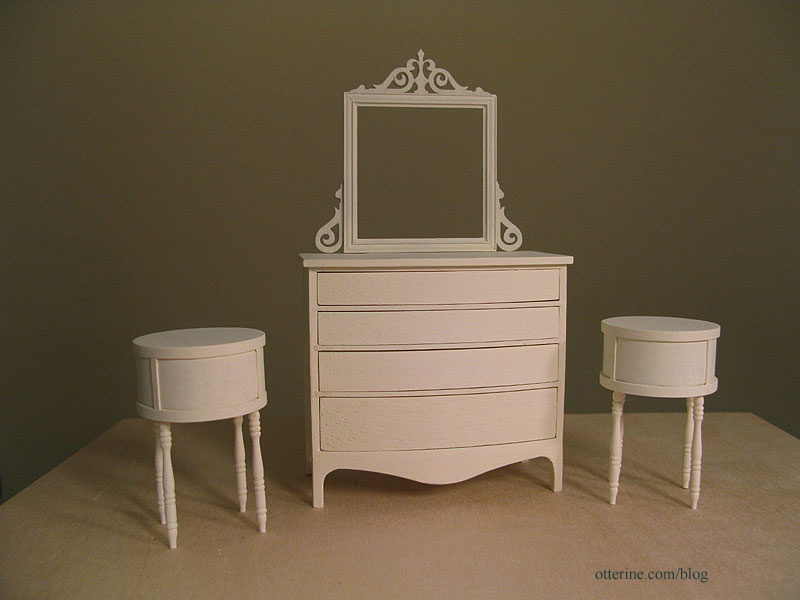
The dresser construction left some gaps between the parts, so I spackled and sanded those seams before painting.
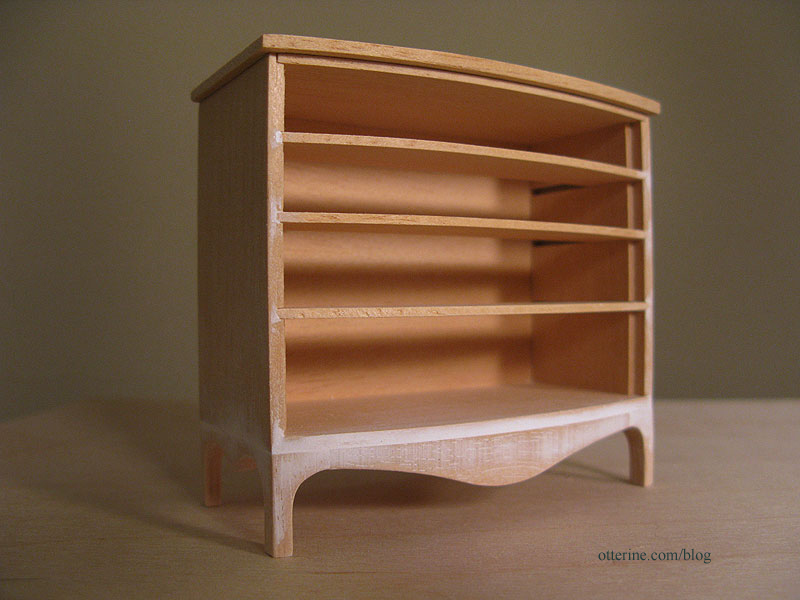
The dresser drawers have been sanded to fit. I’m always wary of that phrase. I bumped a corner on only one drawer, so I think I did pretty well.
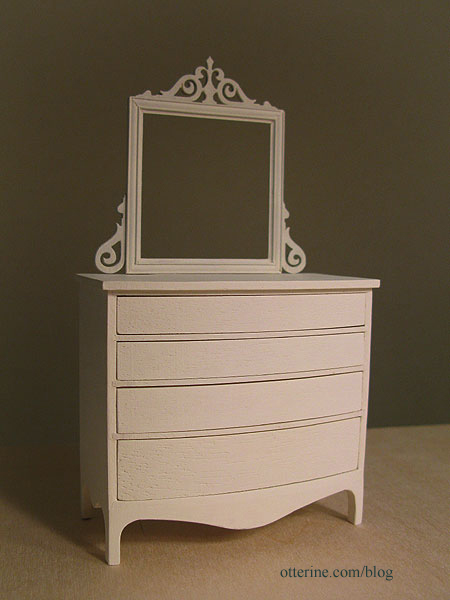
The kit didn’t fit all that well in the front – the drawers were too recessed in comparison to the dividing panels. I added a shim of veneer to the inside back. This helped level the drawers in front by pushing them forward slightly.
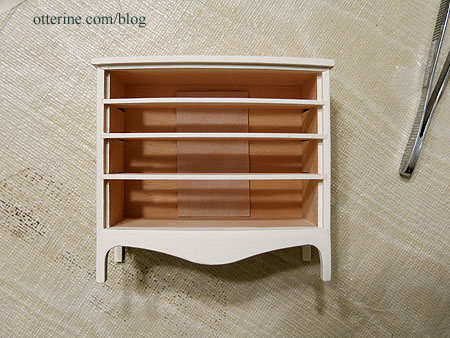
I wanted a painted finish with branches, flowers and birds, so I bought some small detailing brushes for fine painting.
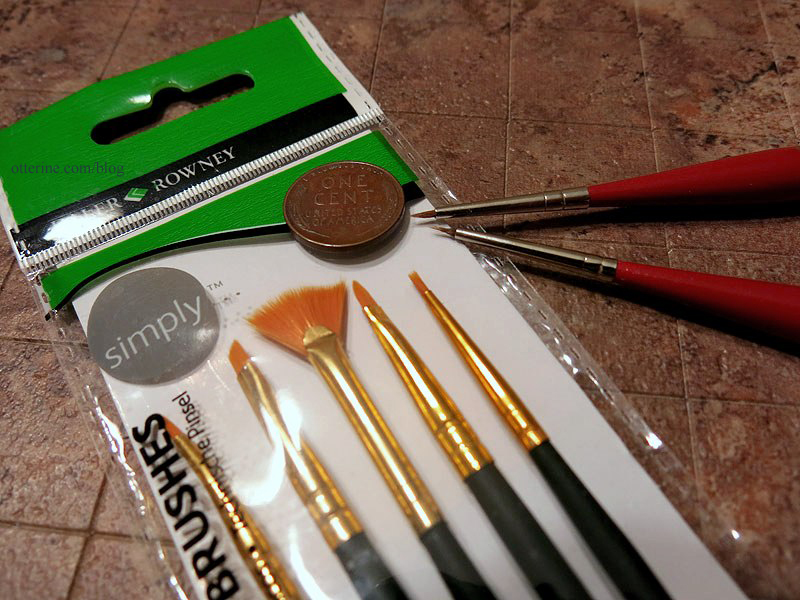
I added an aging wash and then painted on the branches. The nice thing about making a vintage painted dresser is if you mess it up, you just wipe away the paint. And residue just adds to the age and depth of painting.
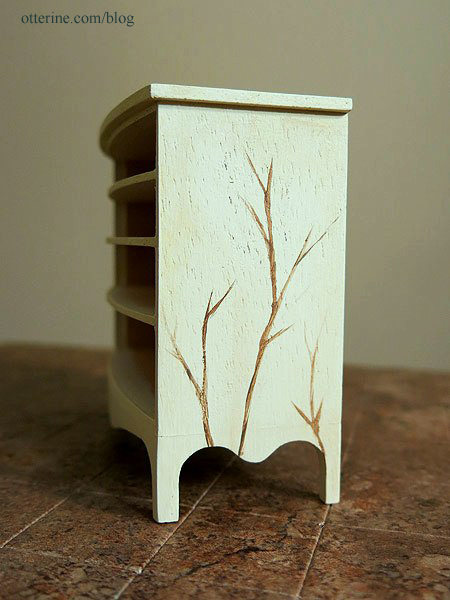
To paint the front, I added the drawers.
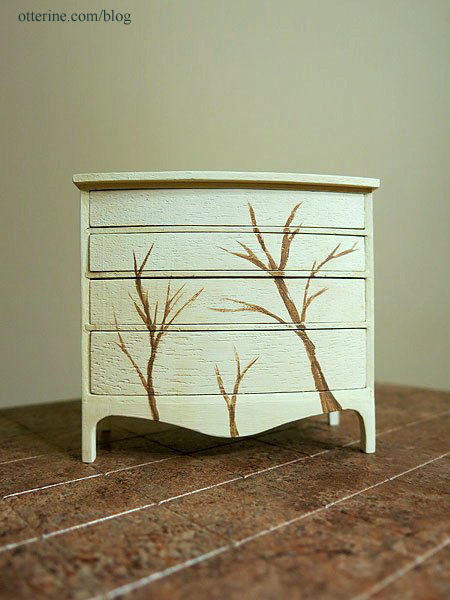
Once I had the branches painted, I masked off the top.
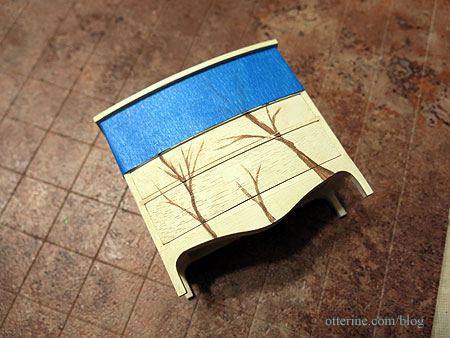
I painted it to look like stained wood. There are a few imperfections in the wood that I could not sand out in the initial construction, but it works well for a vintage piece.
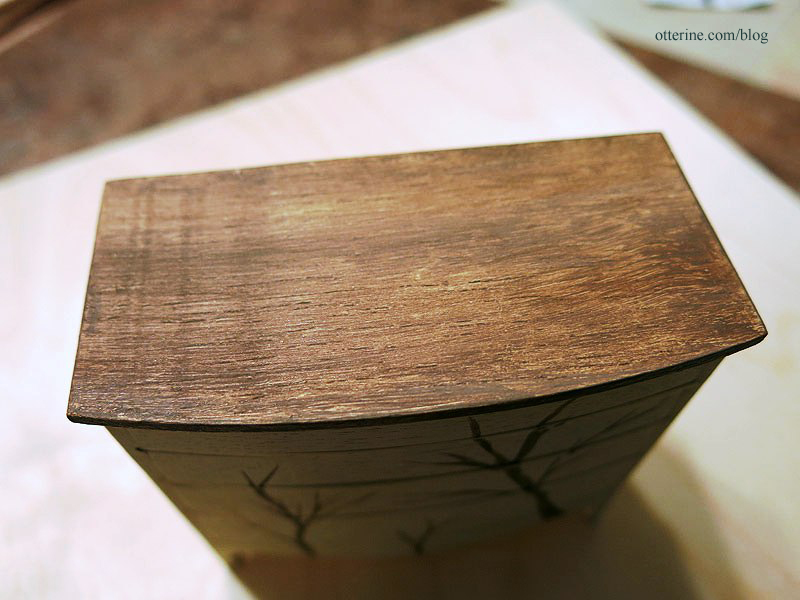
With the mirror propped in place, it looks like we’re getting somewhere.
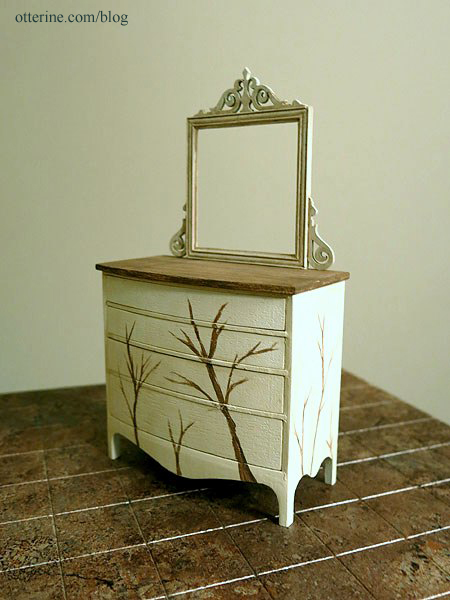
I rather like it with just the branches, but I wonder if it looks too incomplete like this…hmm…
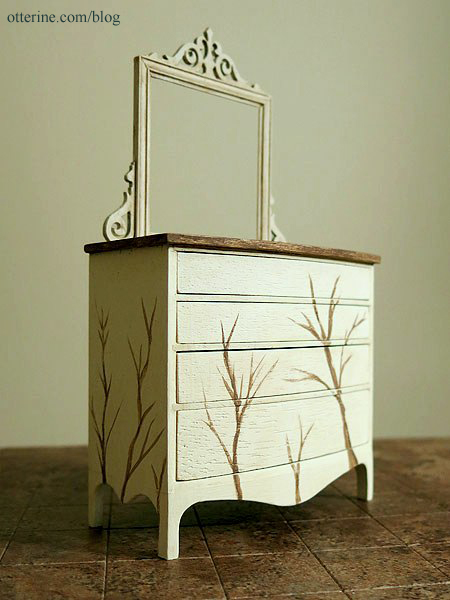
Categories: Furniture, The Haunted Heritage
July 13, 2013 | 0 commentsNew minis
Even though I don’t have a build started for this beautiful bed, it’s hard to pass up pieces that speak to me. I’ve noticed that if I skip over something, it tends to be sold out and out of production by the time I’m ready for it. I picked up this lovely bed from Regent Miniatures (a new name for a long time supplier on eBay).
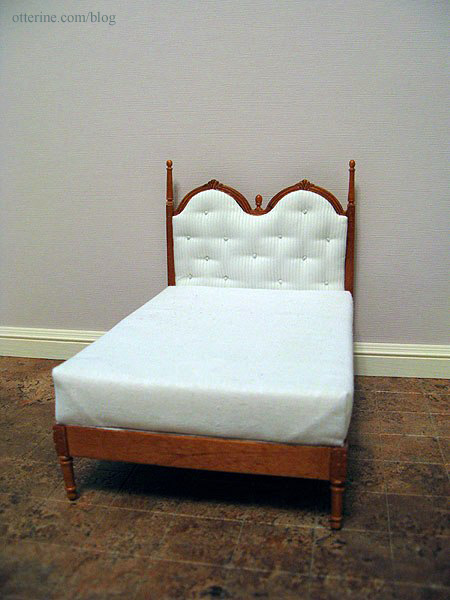
It has wonderful vintage styling with crisp white upholstery.
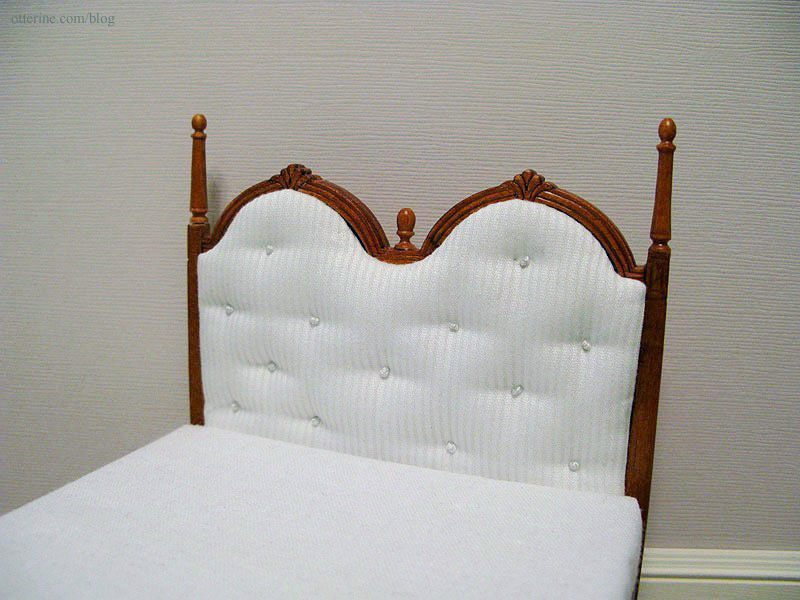
I also had a recent business trip to Vancouver, British Columbia where I had a couple of days for personal touring, too. It was my first time there, and I definitely want to go back.
I had brought some needlework with me, but it was pretty much a non-stop series of events between meetings, meals and activities. During my off weekend, I stopped at Ross’ Miniatures in North Vancouver. Mary was so helpful and friendly. I was able to find a number of interesting and vintage items.
This Timberbrook closet kit comes with working sliding doors and wood pieces to make an enclosed closet.
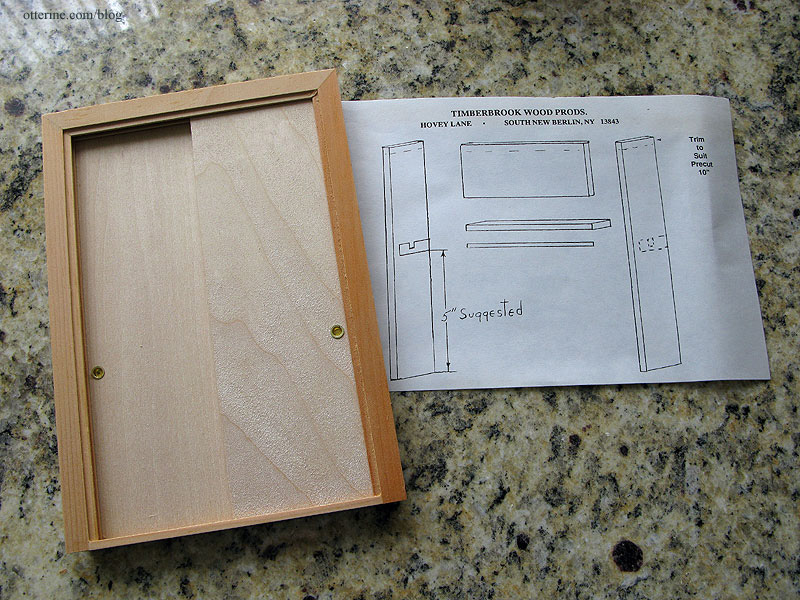
These are no longer made and hard to find.
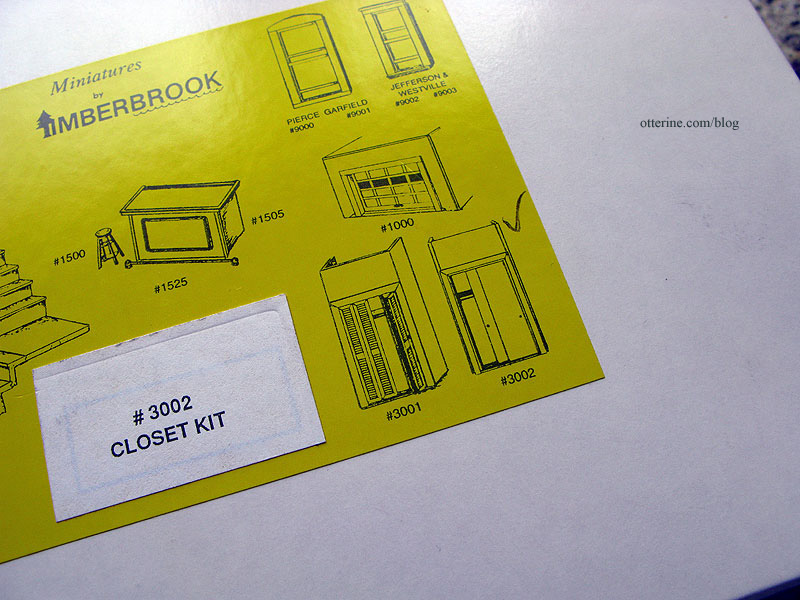
I bought a number of packages of brackets for The Brownstone. The ones that came with the kit require assembly and since I plan to add to the overall structure, there would not be enough of them to go around.
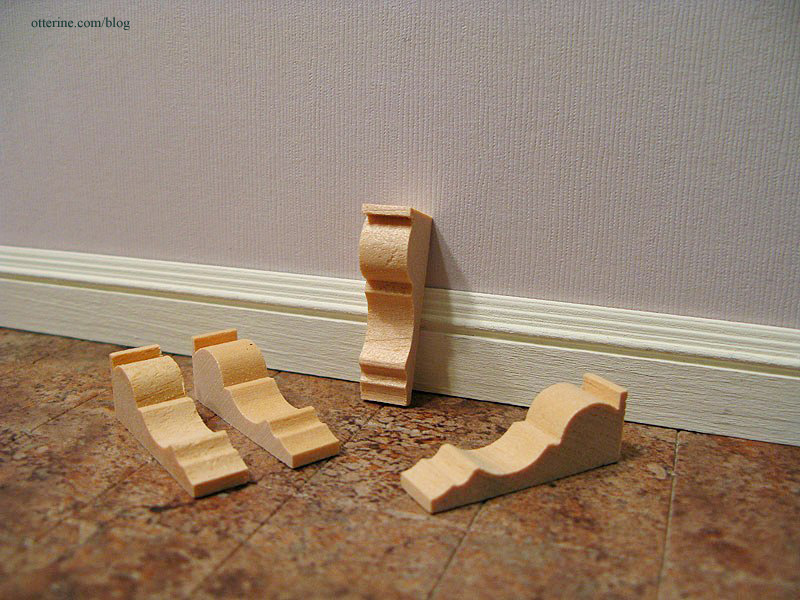
I found a contemporary chair and side table. I’ve never seen anything like these before.
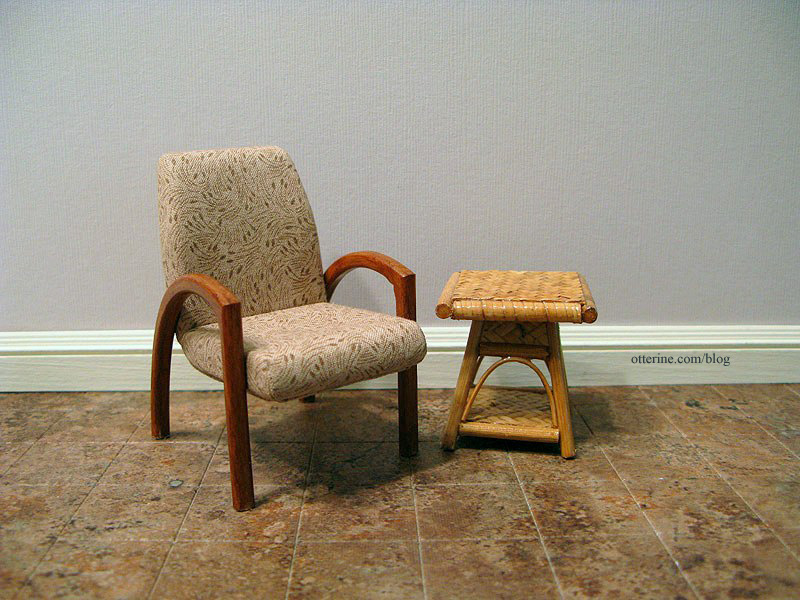
While I was away, some fun new minis from Blake at A Bohemian Bazaar arrived at home. They are so well made and so tiny!
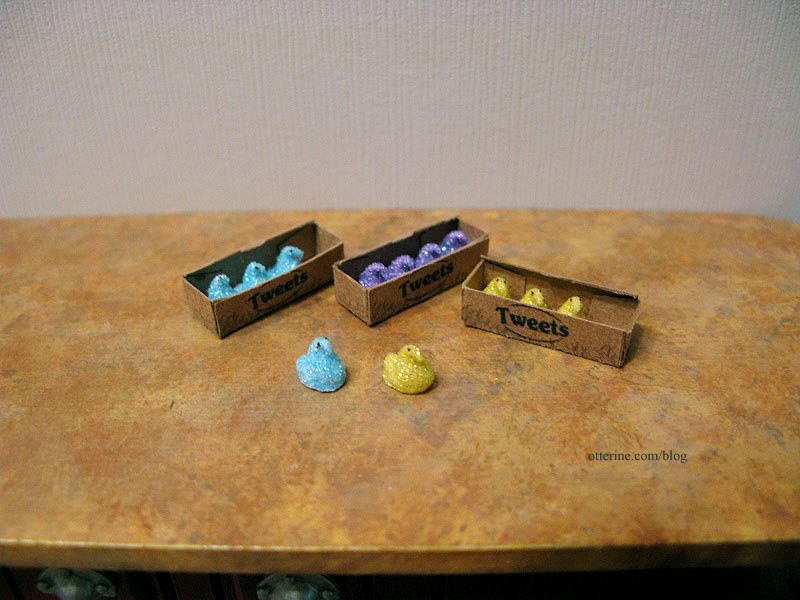
Categories: Furniture, Miniature Shows and Shops
June 29, 2013 | 0 commentsThe Artist’s Studio – Daybed, part 1
The daybed I’ve been using in The Artist’s Studio is one that I had in my collection and wasn’t necessarily meant for this space. I painted it burnished copper to coordinate better with the other furnishings.
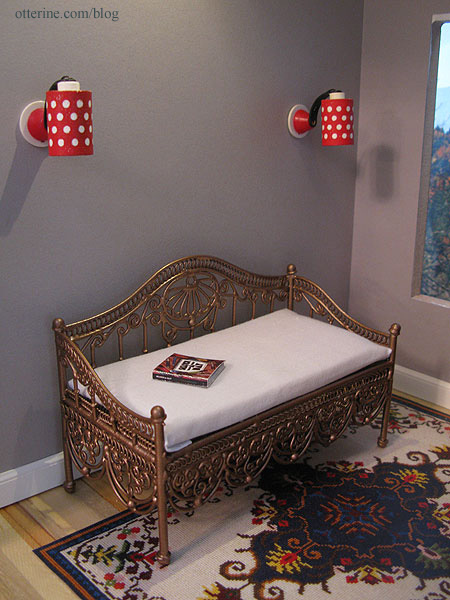
The problem with it is that even though it’s a good size for the room, it’s not really a daybed so much as a settee. My model can’t comfortably recline on it.
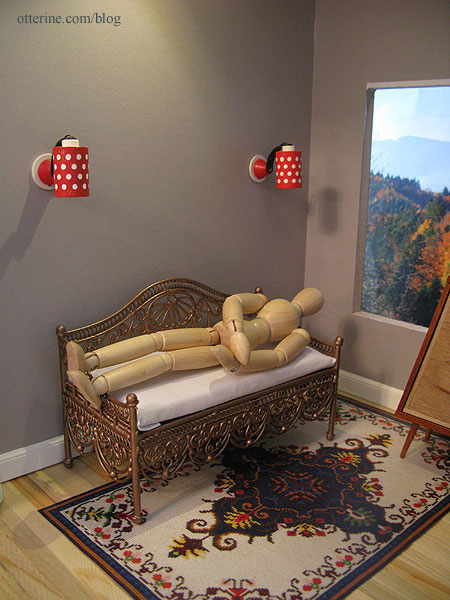
I have a sofa kit in my collection of furniture kits that might work better. It’s from the Realife Miniatures Country Living Room kit.
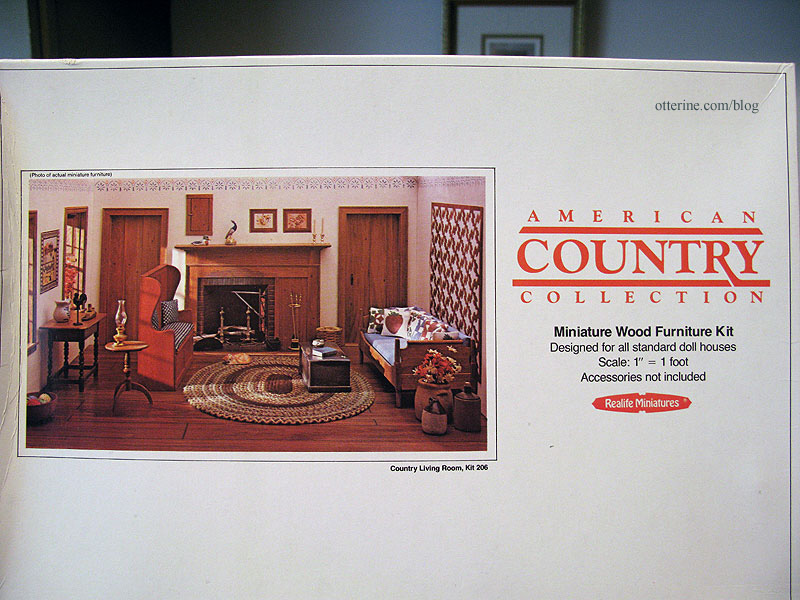
I’ve wanted to build this sofa for awhile now, so today I put it together. I’ve been spoiled by House of Miniatures and precision laser cut kits. The fit is sloppy in places, but paint will take care of that!
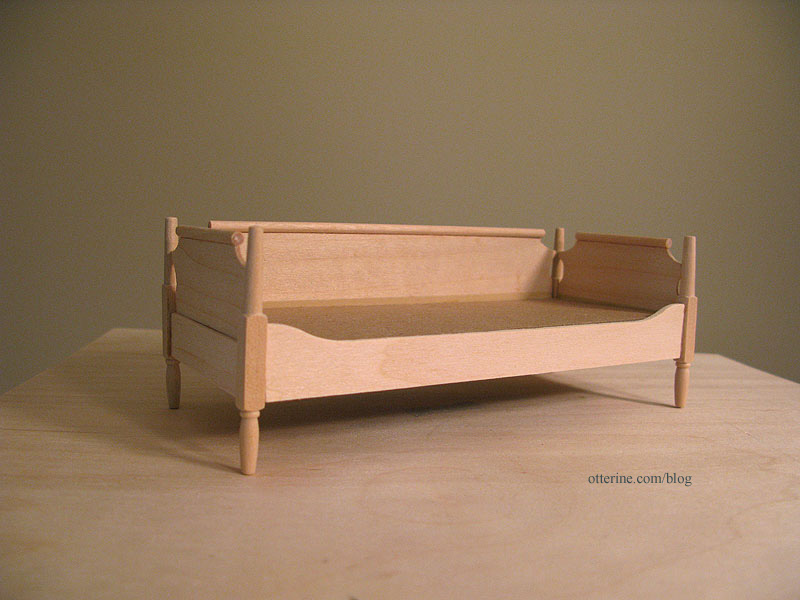
This sofa is lower but wider than the original settee, and my model seems much more comfortable.
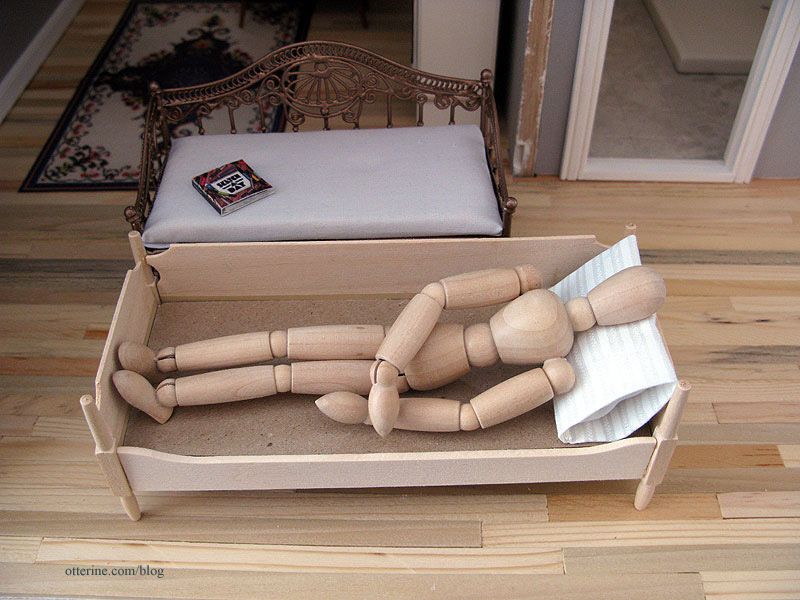
It fits well in the space, too. :D
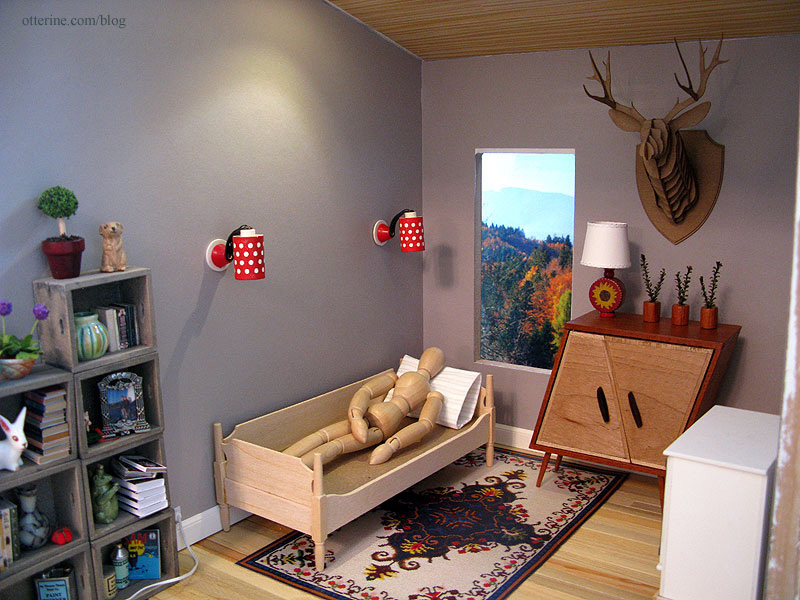
Categories: Furniture, The Artist's Studio
February 24, 2013 | 0 commentsBespaq bed makeover, part 1
You might recall from my previous post, this is where the bed started. The finish was too dark and the bedding too large for scale.
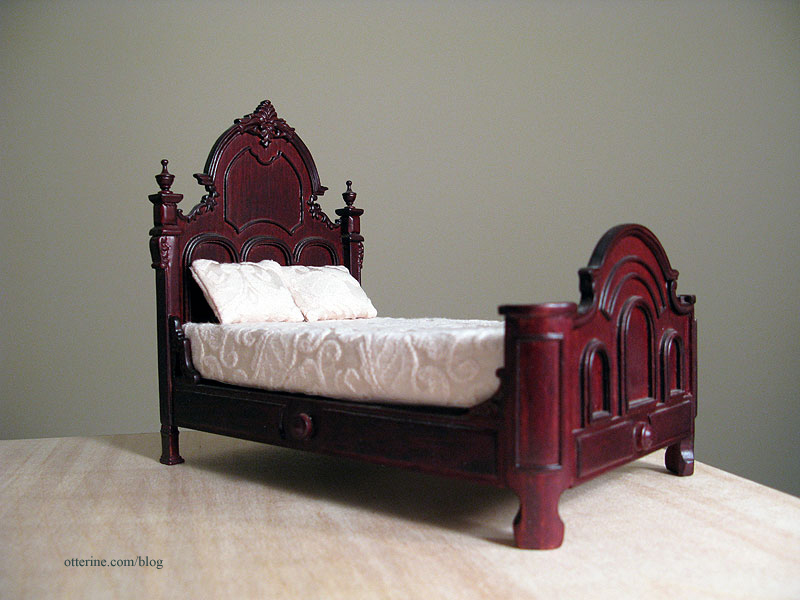
I then primed it with grey spray paint to cover the red wood and varnish shine. Of course, I didn’t take a better photo of it in grey. :\
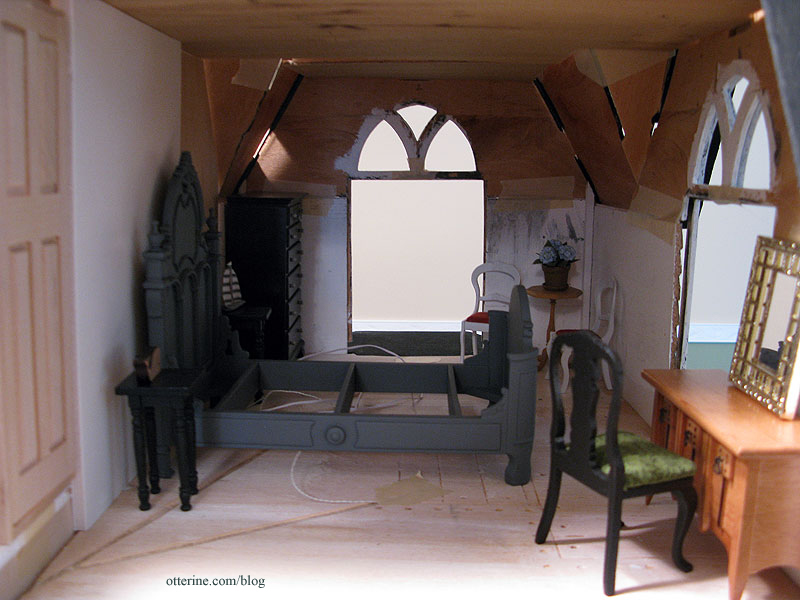
Here it is after a few coats of Krylon Almond in satin finish. :D We’re already getting somewhere!
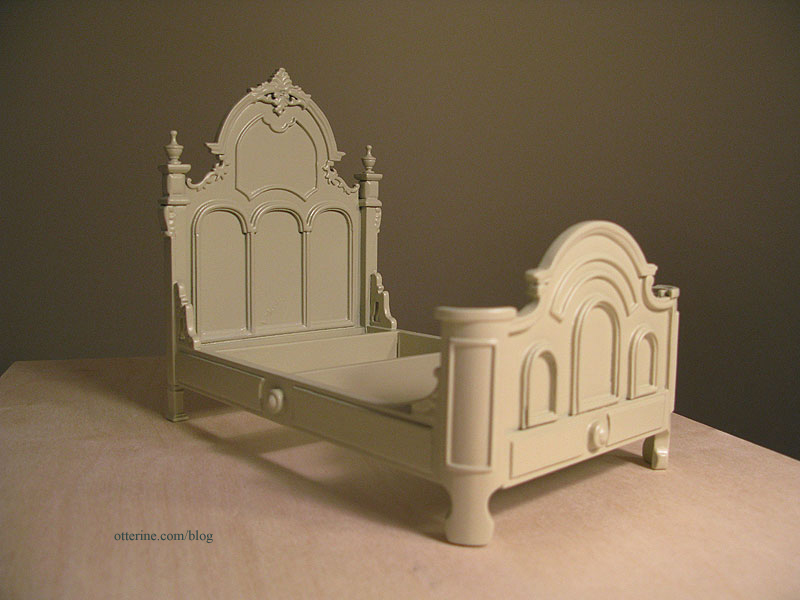
There are a few imperfections in the paint coverage, but those will be hidden by the bedding.
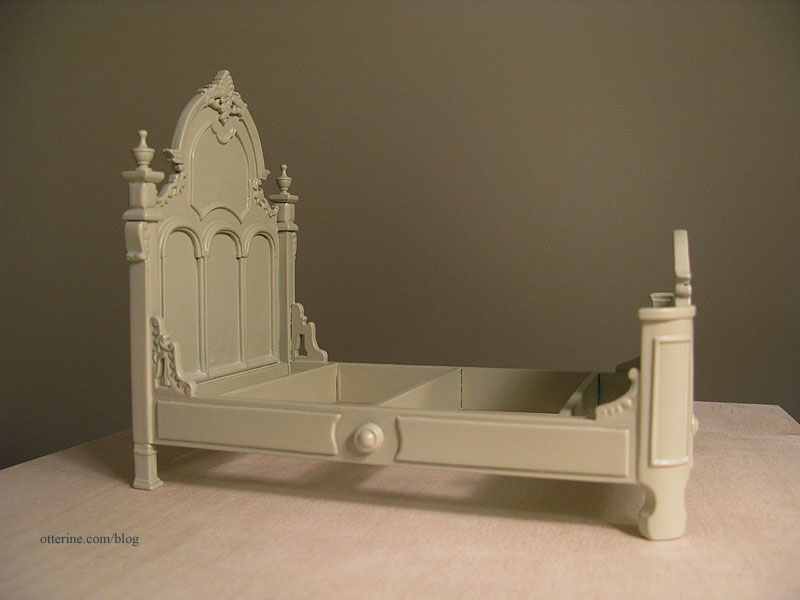
To age the bed, I removed some of the Krylon Almond satin paint using a sanding stick. I picked up a package of these at Hobby Lobby.
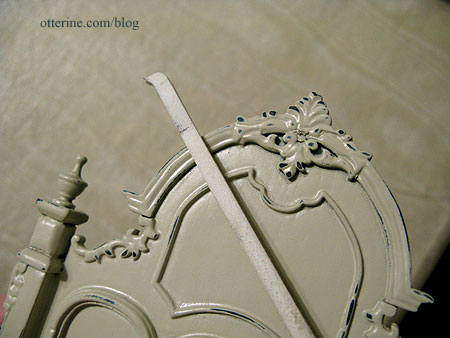
I went for a little less wear than my inspiration photo.
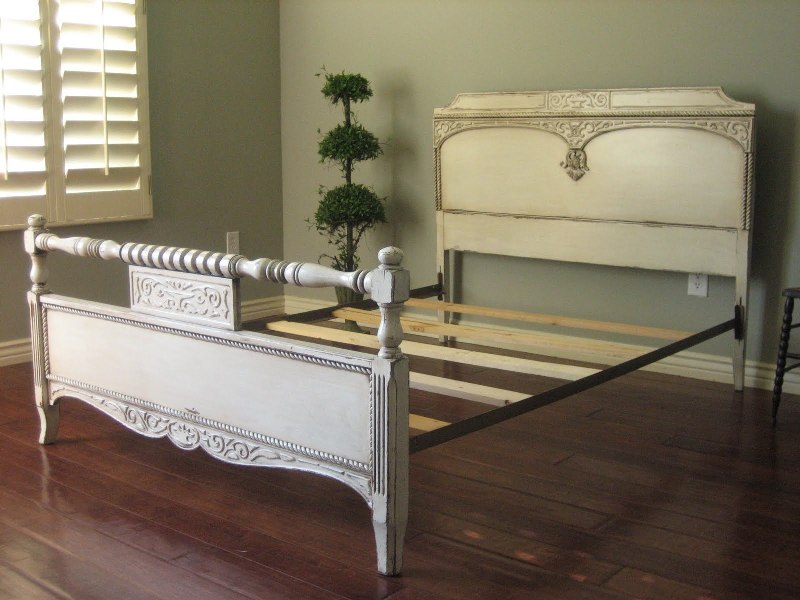
image from European Paint Finishes Detail of the wear patterns on the inspiration bed.
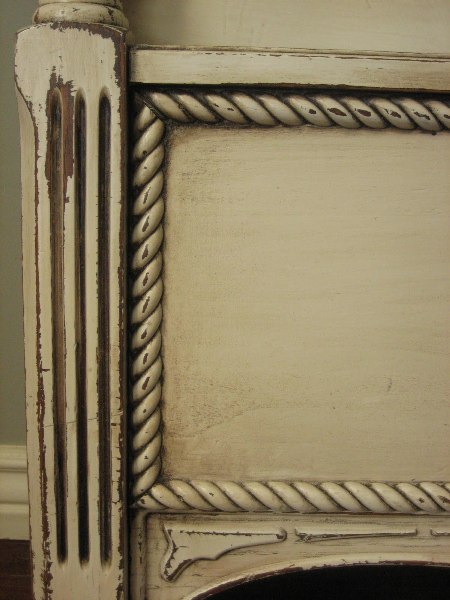
Detail of the wear on my bed. I wanted to emphasize the lines and details of the bed without overdoing it, especially since miniature finishes tend to work best when they are subtle.
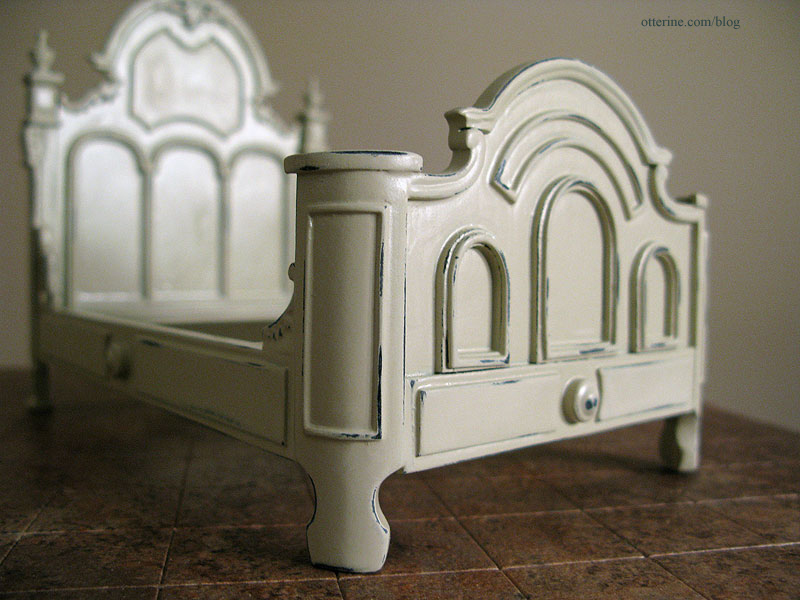
I dry brushed some brown paint into the grooves and recesses, again using only a little. It added some nice depth.
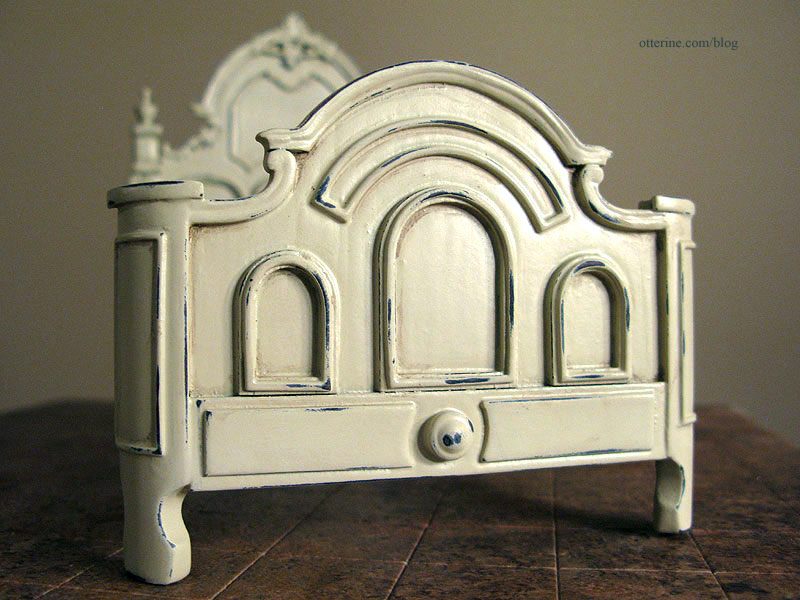
I cut new foam core board pieces to replace the original mattress.
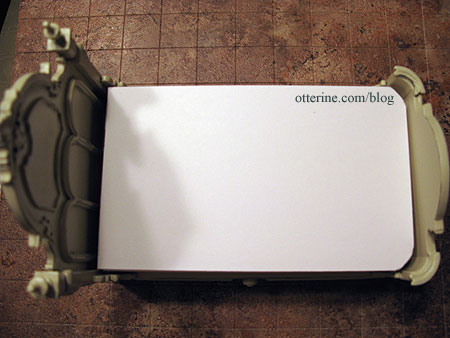
We’re ready for bedding!
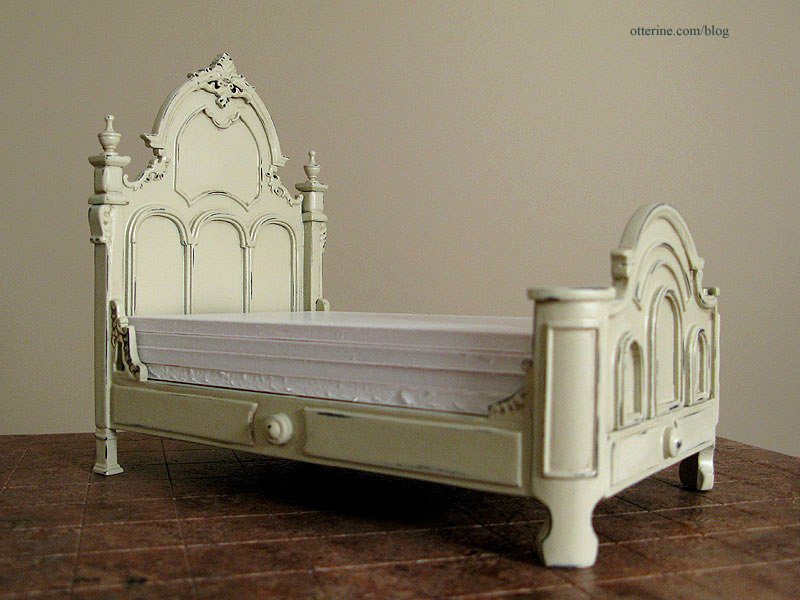
The bed looks somehow heavier now than it did in plain almond, don’t you think? :D
Categories: Furniture, The Haunted Heritage
December 28, 2012 | 0 commentsGrandma’s comfy chair
I’ve been shopping for a comfy chair for the bedroom, something light in color with a tall back. I had an ah-ha moment when I remembered I had a House of Miniatures Chippendale Wing Chair kit. This was part of a miniatures lot I bought, though I never thought I would end up using this kit.
I bought this fabric some time ago, too (don’t recall from where – likely a local mini show). I love the fabric, but it’s not my usual style…it’s rather vintage. Perfect!
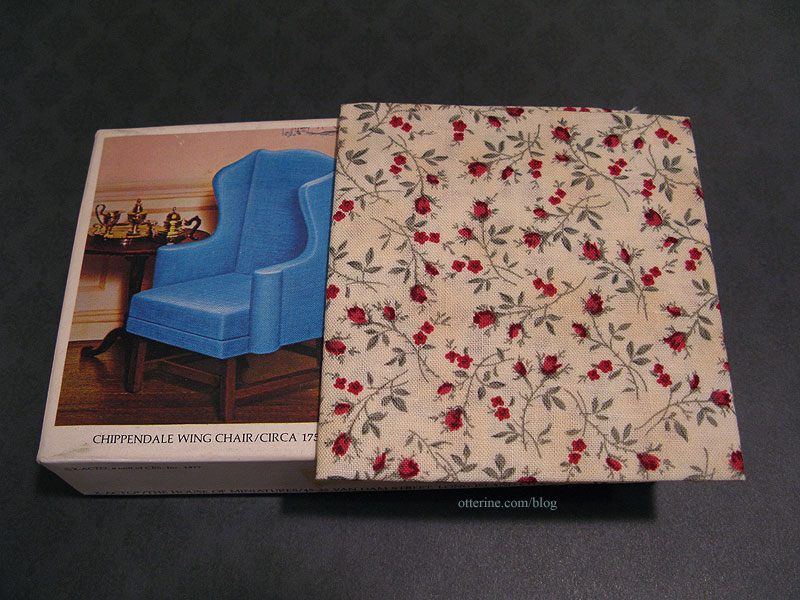
So, I’m going to give it a shot. If it ends up being a disaster, it can always go in the attic. Of course, an old wobbly, threadbare chair would fit so well in the Heritage.
The kit was in near perfect condition, but I needed to make some adjustments. First, the card supplied with the kit is manila-folder type cardstock. It was in usable condition, but it made the fabric appear more yellow when placed underneath. I wanted the chair to be more of a true ivory like the original fabric.
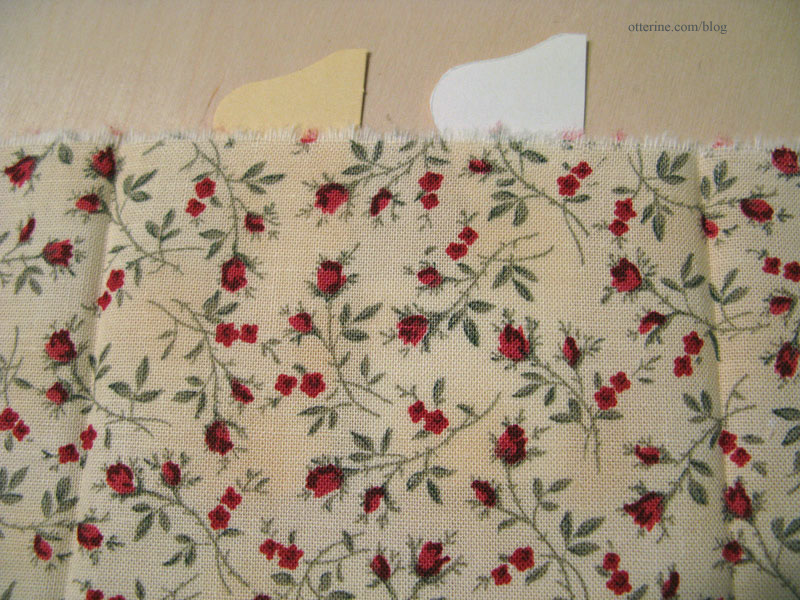
I cut new pieces from some thin white cardboard. It was so thin, I decided to just glue it to the original pattern pieces and use them together. Here they are before gluing.
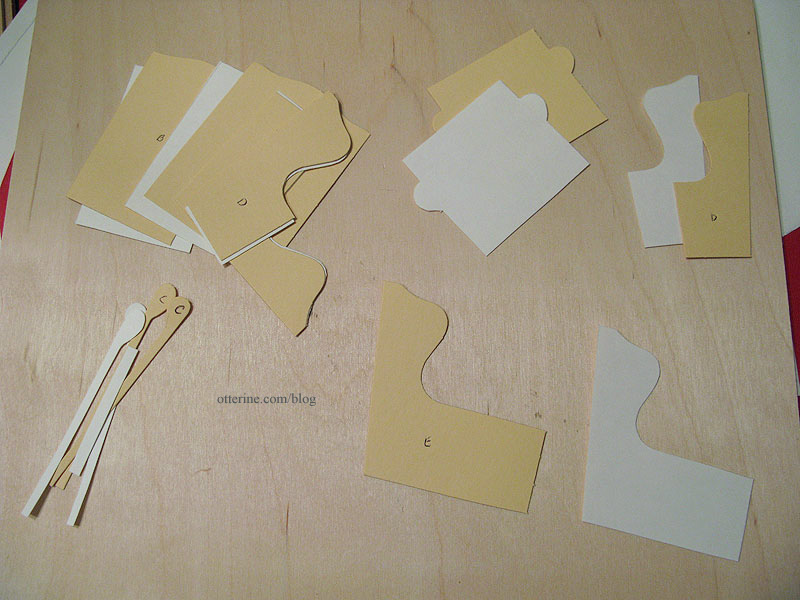
The foam inserts were in better condition than I had expected, but I still didn’t want to risk using them. They were starting to degrade and would probably break down completely over time. I cut layers of millinery batting to replace these foam pieces.
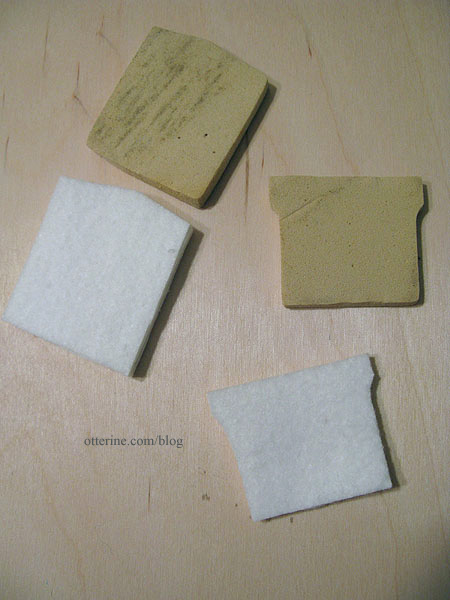
I painted the wood foundation Tapioca by Folk Art. I think it will complement the fabric well. I also didn’t want the legs to be lost in a dark room and make the chair seem like it was floating in air. :D
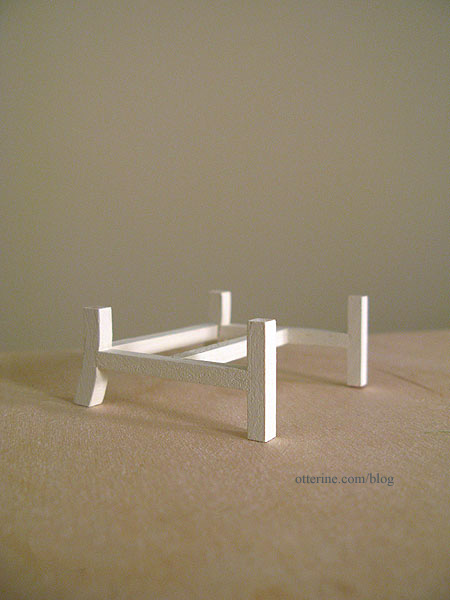
I found the instructions for this kit to be well thought out and adequately descriptive. The illustrations were helpful and made putting the chair together relatively simple. I just followed step by step, and the chair came to life.
Let’s not confuse matters and say it was easy, but simple in the straightforward approach the assembly follows. I did make a few modifications to the directions, and these might not make sense unless you are making this exact kit. I would not have thought to do these things if I hadn’t made the Millie August sofa kit previously. I am so glad I ran into that kit. It taught me a lot of tips and tricks for upholstering mini furniture. Unless otherwise noted, I followed the directions exactly.
In Step 3, the rounded moldings were longer than the chair sides. I glued them so the tops were flush and then sanded the excess from the bottom once the glue was dry. This might not be an issue for all kits.
In Step 8, you are to wrap the fabric around the card piece, including the bottom and back edges. I left these loose and wrapped only the curved front edge. I then glued the card to the side and wrapped the back and bottom edges around the wood, cutting flush with the opposite side. Otherwise, I would risk the fabric pieces not matching up with the back and seat coverings added later, therefore leaving gaps. (Doing this actually saved the piece in the end.)
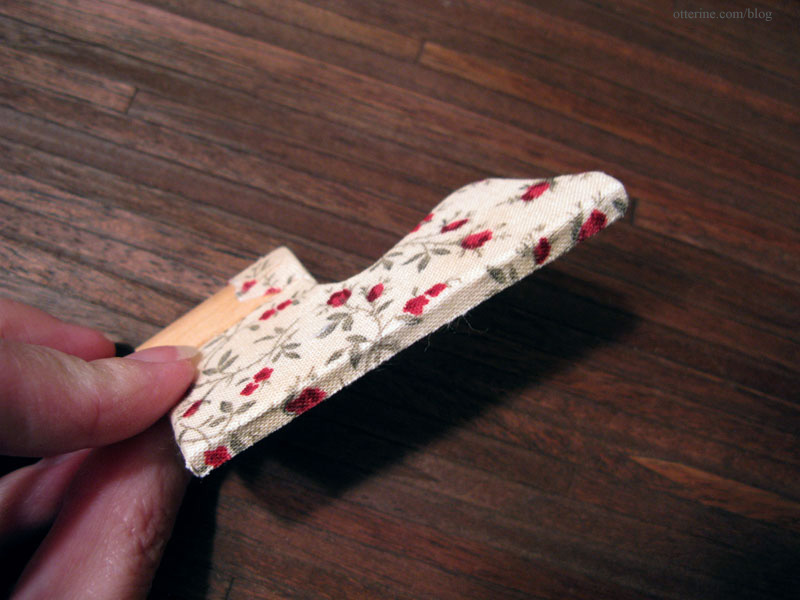
In Step 9, I wrapped all edges of the card except those around the bottom of the rolled edge.
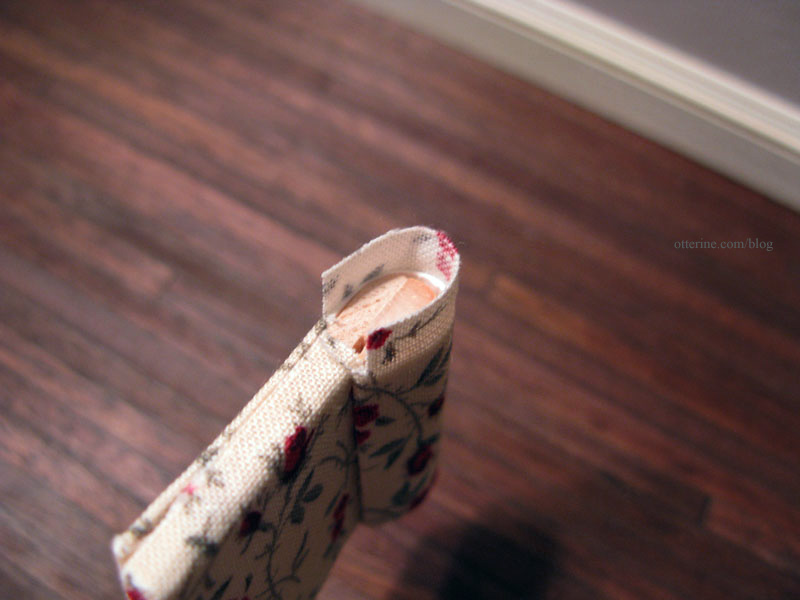
I again wrapped these ends under the wood on the bottom. (This did end up being a little bulky in the end, but I would have had gaps without doing it so it was worth it.)
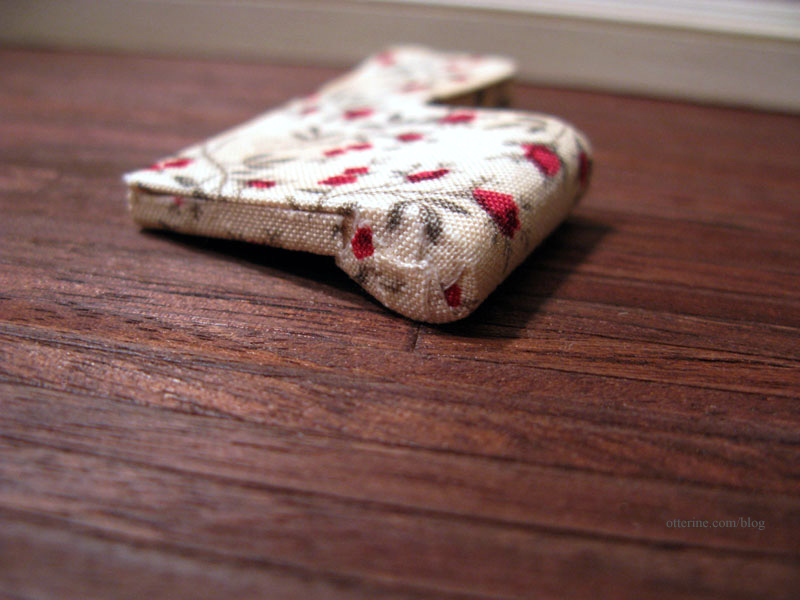
Any gaps along the back or bottom edges for Step 9 won’t matter since these are joined on the inside with the back and seat to form the chair.
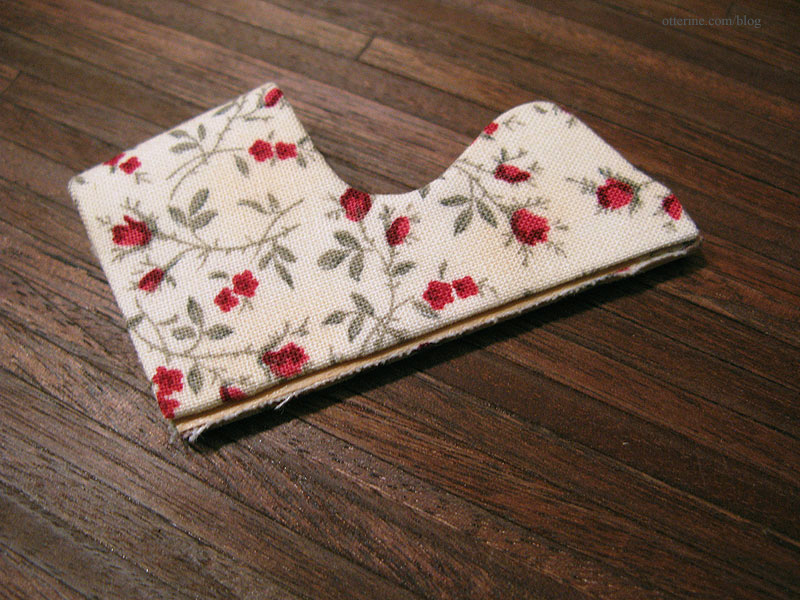
I did plan having roses centered on the arm rests, but I left the pattern random for the rest of the chair. :]
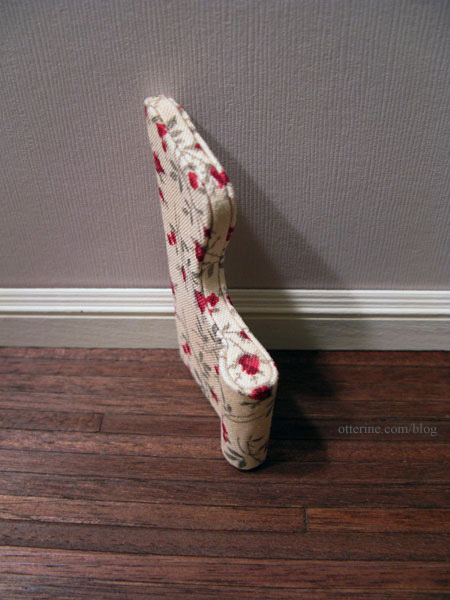
I will point out that you may need to cut new card pieces. A couple of the pieces were shorter than needed. I had to cut completely new pieces for D and E in Steps 8 and 9 for the second of the side assemblies, even though the first side worked perfectly with the original card pieces. Here you can see just how off the original piece E was around the front curve.
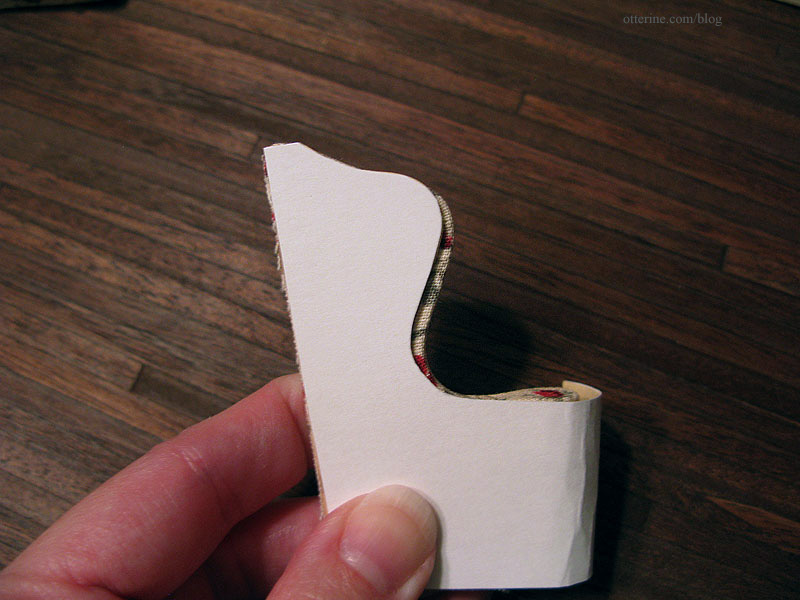
The patterns aren’t very precise, especially after you’ve added fabric in previous steps. Depending on the lightness of your fabric any shortness around the edges may show. Here you can see a little of the wood underneath at the bottom of the rolled edge. This should end up looking like nothing more than a shadow and not be obvious in the end.
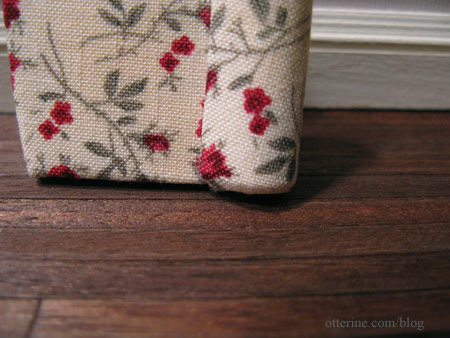
I should add, too, that the white card I added to the kit card pieces to make the color of the fabric truer did not interfere with the assembly of the chair. It might have resulted in slightly thicker “piping” around the pieces, but it still looks in scale. If you add anything, though, it has to be very thin or take over for the kit supplied card in like thickness.
In Step 12, I painted the chair base (piece 52) white before adding the fabric. Otherwise, the fabric would have appeared darker on this piece due to being over bare wood instead of white card or white batting.
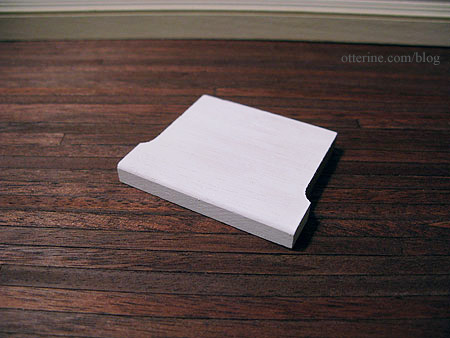
Also, since I wasn’t using the more rigid foam for the back cushion, I cut an extra piece of card for the back of the millinery batting layers to make it easier to cover with fabric.
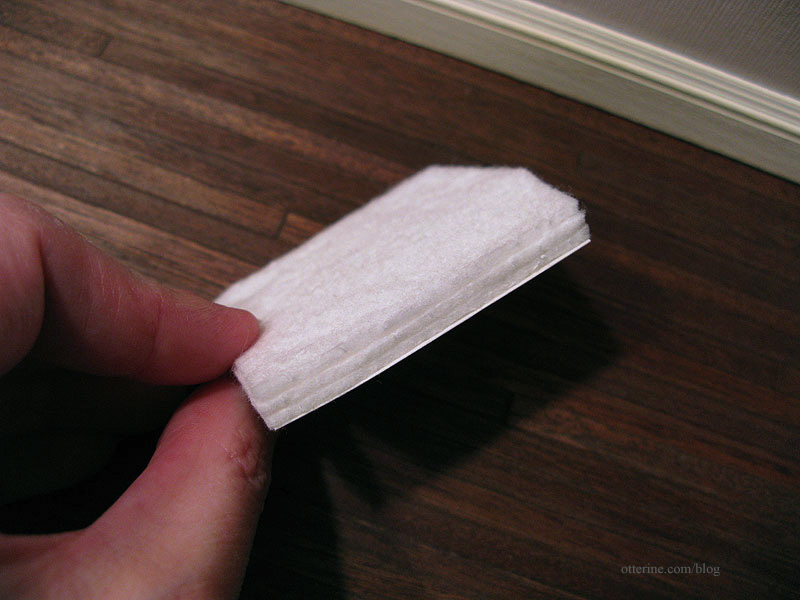
In Step 13, I painted the edges of the seat cushion white for the same reason I had done so for the chair base.
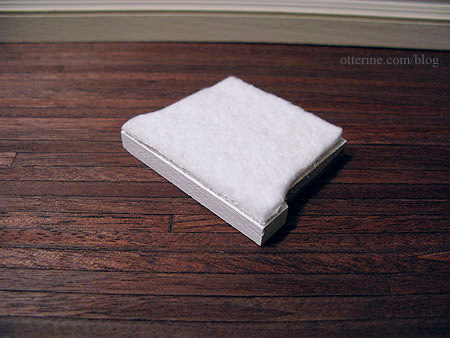
In Step 14, for the actual assembly of the fabric covered pieces, I glued the back to the seat as indicated. I then glued on one side, but this is where I deviated from the instructions. I glued in the seat cushion next.
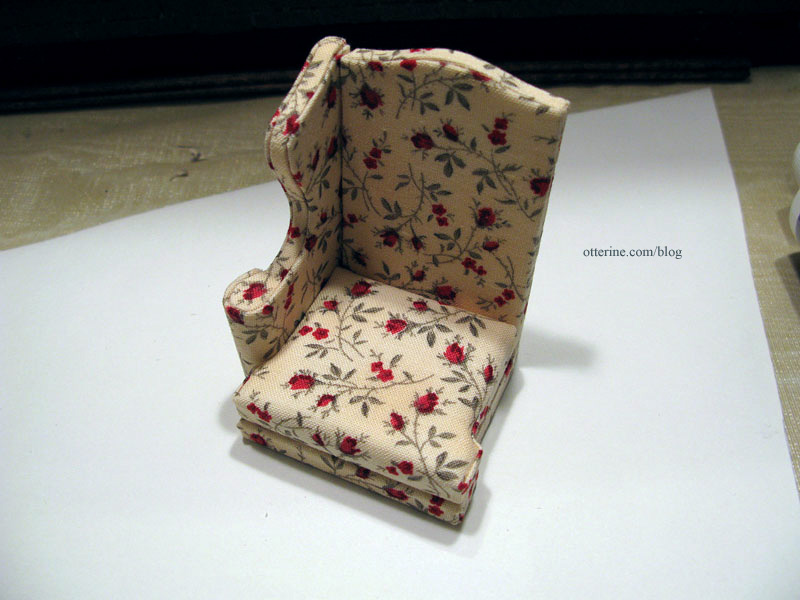
I then glued in the back cushion and slathered on the glue.
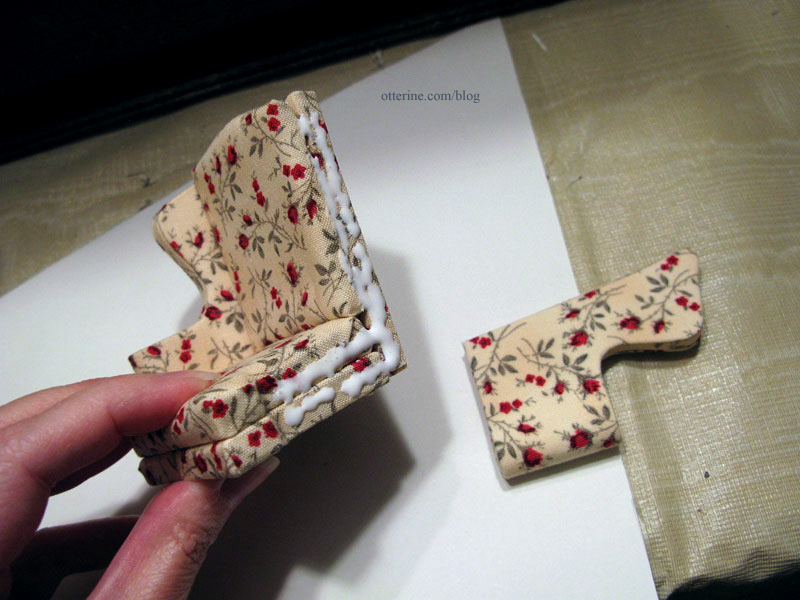
I then glued on the other side. This ensured a good, solid fit for all the pieces instead of waiting until the end to try to make adjustments. One happy accident: using millinery batting instead of a solid foam piece for the back cushion resulted in a delightfully saggy back to the chair. It looks like it has been well-loved all these years. :D
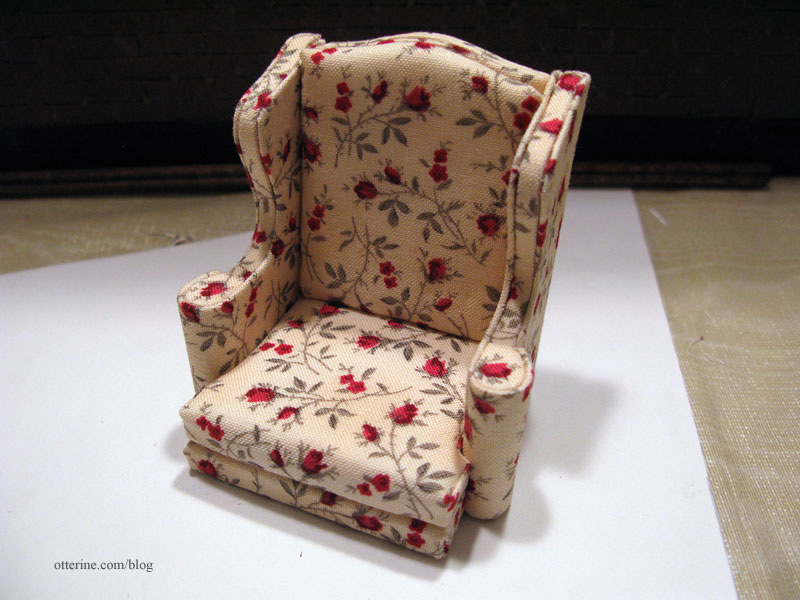
The Tapioca paint on the foundation ended up being a little too light when paired with the fabric, so I added a coat of warmer yellow. I mixed the paint on the fly to coordinate, and I’ll never be able to replicate it.
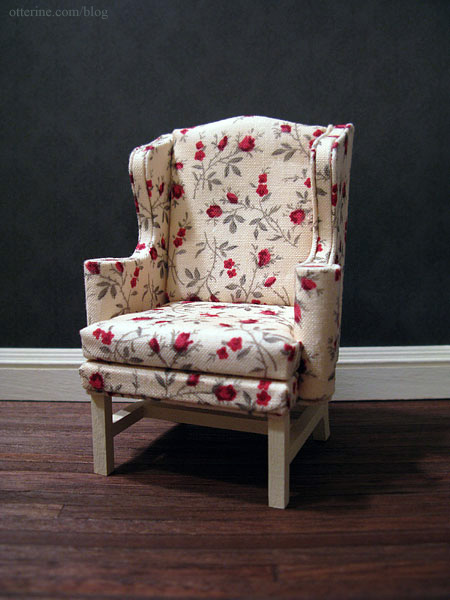
I think the chair turned out very well and I’m so pleased with it. I think using patterned fabric helps hide any inconsistencies that the solid blue fabric included with the kit would have accentuated.
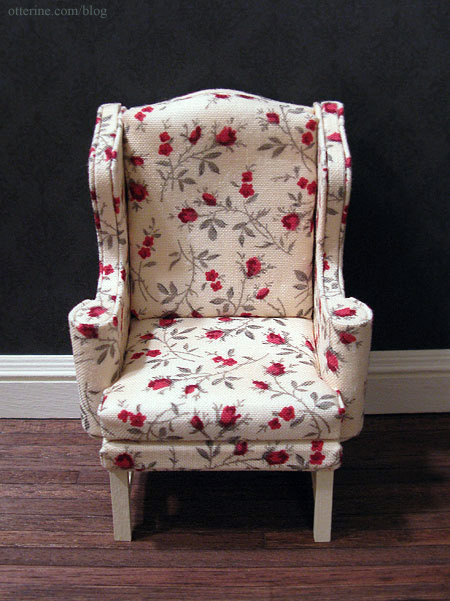
In fact, I love the fabric I used. It’s just the sort of feminine touch I was after. The piece I used was 11″ x 11″ and, with careful planning, I had just enough. If you use a fabric with a pattern that needs to be matched, you might need a larger piece. Interestingly, the black and white photo shown on the instruction sheet shows a similar floral pattern.
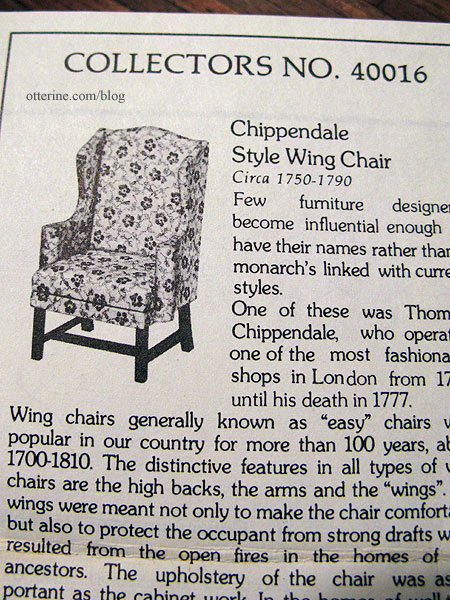
If I were to to this kit again, I would change out the simplistic base. It’s fine enough in the bedroom since it sits in a corner where the bed blocks the view of the base.
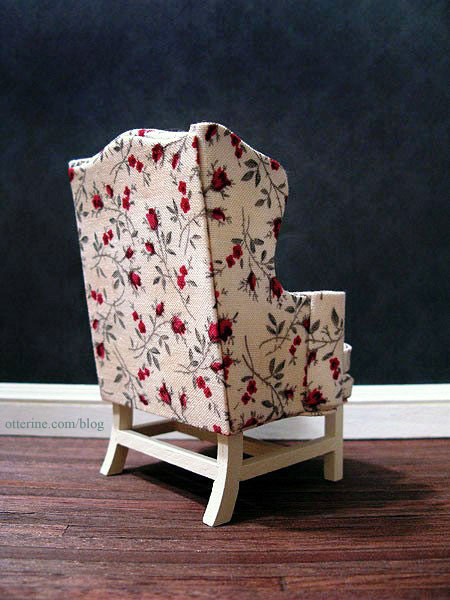
I’ve added one of my white patterned pillows with lace flower detailing. It was the only one I had on hand that coordinated well. A red one might be nice, too.
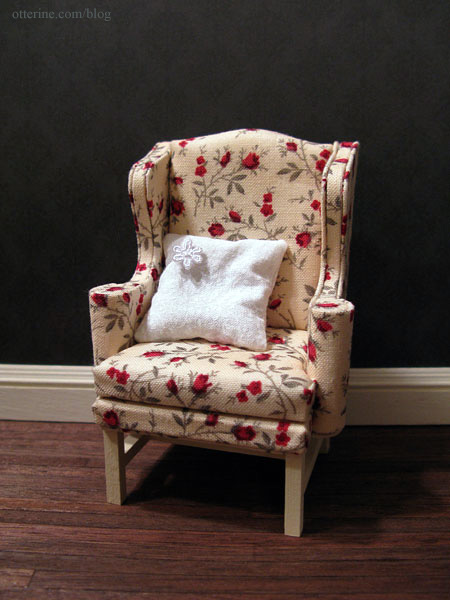
Considering I didn’t think I’d ever end up using this kit (it was included in a lot I bought), I might be inclined to pick up another if I find a good deal. :] It really is a classic design that can be so many things depending on the fabric. Ophelia loves it.
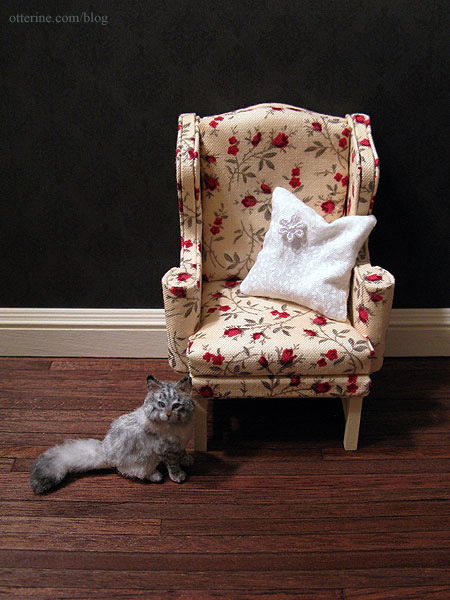
Miss Kitty loves it, too. :D
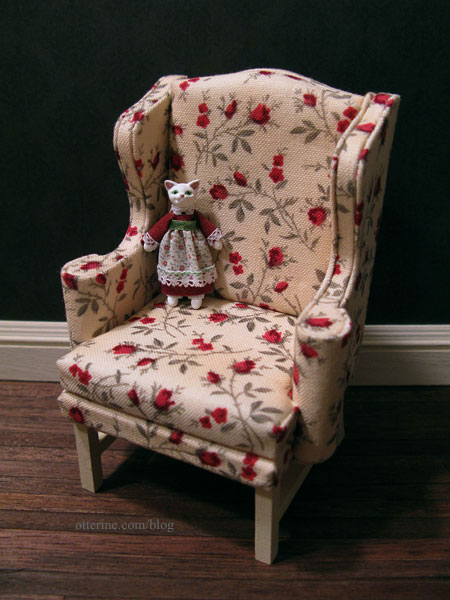
Categories: Furniture, The Haunted Heritage
November 14, 2012 | 0 comments
NOTE: All content on otterine.com is copyrighted and may not be reproduced in part or in whole. It takes a lot of time and effort to write and photograph for my blog. Please ask permission before reproducing any of my content. (More on copyright)



